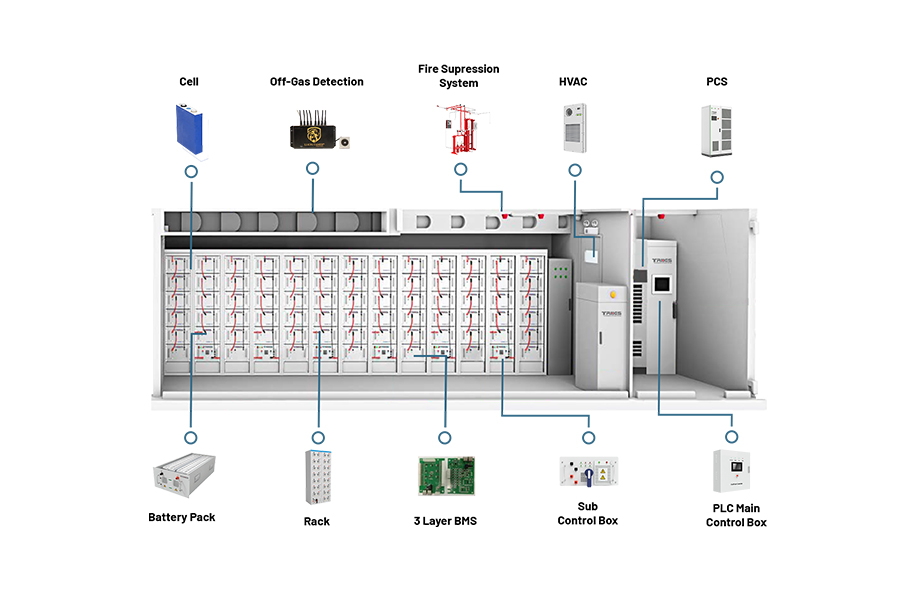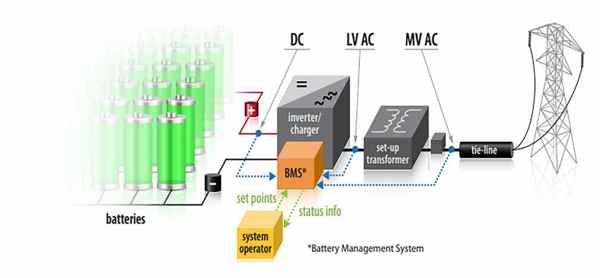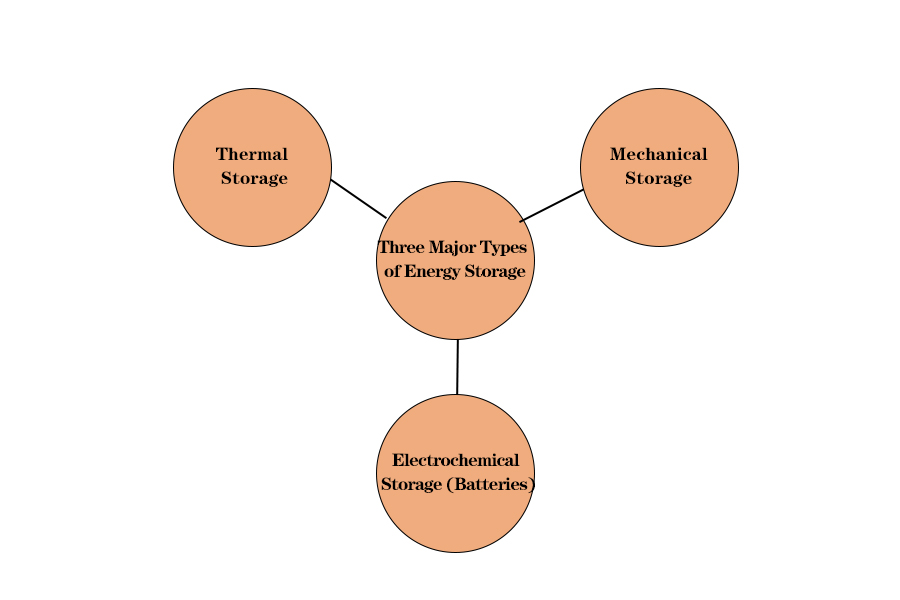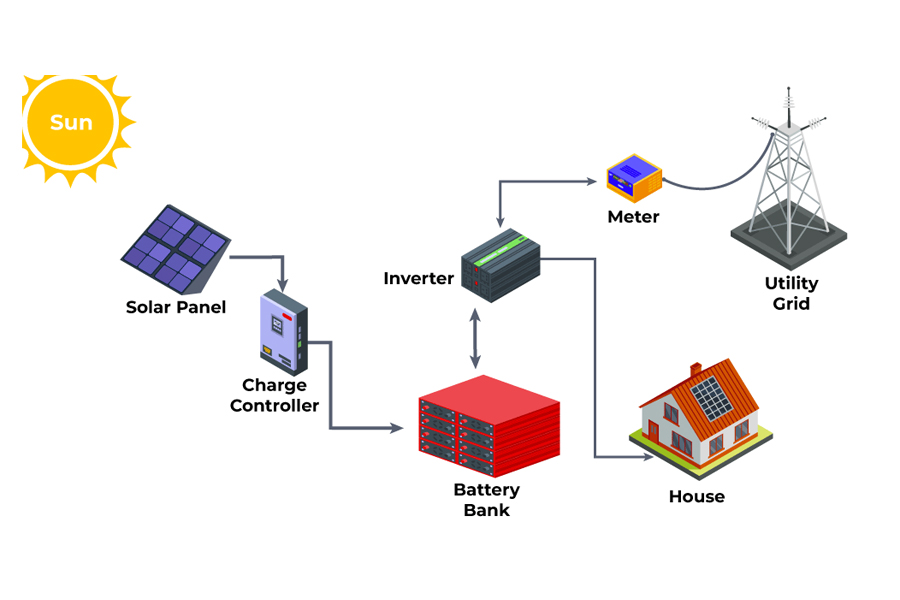Qual é a diferença entre uma bateria e um bess?
Você está explorando opções de armazenamento de energia e se encontrando um pouco emaranhado na terminologia? Você pode ouvir "bateria" e "Bess" usado, às vezes de forma intercambiável, Mas eles são realmente a mesma coisa? Compreender essa distinção é fundamental para fazer escolhas informadas sobre sua energia futura, seja para sua casa, negócios, ou projetos maiores.
A maneira mais simples de dizer é que uma "bateria" (ou mais precisamente, células de bateria e módulos) é o componente central que armazena quimicamente a energia elétrica. Pense nisso como o tanque de combustível. Um bess (Sistema de armazenamento de energia de bateria), por outro lado, é o inteiro, Solução totalmente integrada que não inclui apenas as baterias, mas também um sofisticado sistema de gerenciamento de bateria (BMS), um sistema de conversão de energia (PCs) Como um inversor, Software de controle crucial, e toda a segurança necessária e componentes auxiliares. O bess é o completo, "motor operacional" Pronto para conectar e entregar energia.

No Gicx Solar, Projetamos e instalamos soluções abrangentes do Bess. Enquanto as próprias baterias são vitais, É a integração inteligente de todos os componentes do sistema que desbloqueia a verdadeira independência energética, eficiência, e segurança para nossos clientes.
Vamos nos aprofundar no que realmente é um bess e responder a algumas perguntas comuns.
O que é um sistema de armazenamento de energia Bess?
Você já ouviu o acrônimo Bess, Mas o que isso realmente abrange? O que o torna mais do que apenas uma grande bateria? Um sistema de armazenamento de energia da bateria é sofisticado, solução independente projetada para armazenar energia elétrica quando é abundante (Como nos seus painéis solares durante o dia, ou da grade durante o horário de pico) e depois solte quando necessário.
Um Bess é um sistema totalmente integrado que gerencia inteligentemente a energia armazenada. Seus componentes principais incluem:
- Módulos da bateria: Estes contêm as células da bateria real (Muitas vezes, fosfato de ferro de lítio para segurança e longevidade no moderno Bess).
- Sistema de gerenciamento de bateria (BMS): O "cérebro crucial" Para as baterias, garantir que eles operem com segurança e eficiência, monitorando a temperatura, tensão, atual, e equilíbrio de células.
- Sistema de conversão de energia (PCs): Normalmente, é um inversor/retificador bidirecional que converte a energia CC das baterias em energia CA para sua casa ou carga comercial, e converte a energia CA (da solar ou da grade) para a energia DC para carregar as baterias.
- Sistema de controle & Software: Gerencia a operação geral, decidir quando cobrar, descarga, e interagir com outras fontes de energia como solar ou grade.
- Segurança & Componentes auxiliares: Inclui disjuntores, fusíveis, Gerenciamento térmico (Sistemas de resfriamento/aquecimento), e muitas vezes detecção/supressão de incêndio para unidades maiores, todos alojados dentro de um gabinete de proteção.

Mergulhe mais fundo: A potência coordenada
Um bess não é apenas um reservatório de energia passivo; É um ativo, parte inteligente do seu ecossistema de energia. O Módulos da bateria estão onde a energia é quimicamente armazenada. O BMS atua como seu guardião dedicado, monitorando constantemente seus sinais vitais, protegendo -os de condições como sobrecarga, Dischar demais, temperaturas extremas, ou corrente excessiva. Ele também executa o equilíbrio de células, que é essencial para maximizar a vida útil das baterias de íon de lítio, Especialmente LFP.
O PCs (inversor) é o cavalo de batalha que converte a energia para frente e para trás. Para um Bess solar, Um inversor híbrido geralmente serve como os PCs, Gerenciando o fluxo de energia entre painéis solares, baterias, a grade, e suas cargas. O sistema de controle é o que torna o Bess Smart. Pode ser programado para otimizar para autoconsumo solar (armazenando excesso de energia solar em vez de exportá -la), Forneça poder de backup durante interrupções, ou até se envolver em pico de barbear (Reduzindo cobranças de pico de alta demanda por empresas, descarregando energia armazenada durante períodos de alto custo).
Todos esses componentes estão alojados juntos, frequentemente em um gabinete elegante para sistemas residenciais ou armários/recipientes robustos para aplicações comerciais e em escala de utilidade, Completo com os mecanismos de segurança necessários como o gerenciamento térmico para manter as baterias operando em sua faixa de temperatura ideal.
No GYCX Solar, Quando falamos sobre o fornecimento de uma solução de armazenamento de energia, Estamos falando sobre entregar um completo, Profissionalmente projetado Bess adaptado às suas necessidades específicas.
Quais são os três tipos de armazenamento de energia?
Enquanto as baterias são um tópico quente, É interessante saber que eles são apenas uma maneira de os humanos descobriram como armazenar energia. Quando olhamos para a imagem mais ampla, Quais são as principais categorias ou tipos de armazenamento de energia usados hoje?
Existem várias maneiras de classificar o armazenamento de energia, Mas três categorias principais frequentemente discutidas são:
- Armazenamento eletroquímico: É aqui que as baterias, incluindo os tipos de íons de lítio e ácido de chumbo usado em Bess, cair. A energia é armazenada através de reações químicas.
- Armazenamento mecânico: Isso envolve armazenar potencial ou energia cinética. Exemplos incluem armazenamento hidrelétrico bombeado (Phs), volantes, e armazenamento de energia de ar comprimido (Caes1. ).
- Armazenamento térmico: Isso envolve armazenar energia na forma de calor ou frio, como armazenamento de sal fundido para energia solar concentrada ou armazenamento de gelo para resfriamento.
Para a maioria das aplicações no local, como armazenamento de energia solar residencial ou energia de backup comercial-o tipo de sistema GYCX Solar é especializado em-armazenamento eletroquímico (especificamente, baterias avançadas como LFP) atualmente é o mais prático, escalável, e tecnologia amplamente adotada.

Mergulhe mais fundo: Um olhar mais amplo para armazenar energia
Vamos explorar brevemente essas categorias:
- Armazenamento eletroquímico (Baterias): Esta é a tecnologia no coração do Bess moderno.
- Como funciona: Converte energia elétrica em energia química durante o carregamento e volta à energia elétrica durante a descarga através de reações redox.
- Exemplos: Íon de lítio (LFP, NMC, LCO), chumbo-ácido, baterias de fluxo, baterias de íons de sódio.
- Prós: Alta densidade de energia para seu tamanho/peso (especialmente íon de lítio), modular e escalável de pequenos dispositivos para escala de utilidade, tempos de resposta rápidos, e custos continuamente decrescentes.
- Contras: Vida útil finita com degradação sobre os ciclos, Algumas preocupações de fornecimento de matéria -prima (Embora o LFP mitiga alguns deles), e desafios de reciclagem no final da vida (que estão melhorando).
- Armazenamento mecânico:
- Armazenamento hidrelétrico bombeado (Phs): Atualmente a maior forma de armazenamento de energia em escala de grade globalmente. A água é bombeada para cima para um reservatório quando a eletricidade é barata/abundante e liberada através de turbinas para gerar eletricidade quando necessário. Altamente eficiente, mas geograficamente restrito e grande investimento de capital.
- Volantes: Armazenar energia cinética em um rotor giratório rapidamente. Excelente para duração muito curta, Aplicações de alta energia, como regulação de frequência ou UPS para processos industriais críticos. Capacidade limitada de armazenamento de energia.
- Armazenamento de energia de ar comprimido (Caes): O ar é comprimido e armazenado em cavernas ou tanques subterrâneos, depois aquecido e expandido através de uma turbina para gerar eletricidade. Grande escala, geograficamente dependente.
- Armazenamento térmico:
- Sal fundido: Usado em energia solar concentrada (Csp) plantas para armazenar calor solar, permitindo geração de eletricidade, mesmo quando o sol não está brilhando.
- Armazenamento de gelo / Água gelada: Usado em grandes edifícios para ar condicionado. O gelo é feito durante o pico (eletricidade mais barata) horas e depois costumava esfriar o edifício durante o horário de pico.
- Outras formas: Também poderíamos mencionar Armazenamento químico (como hidrogênio, onde a eletricidade é usada para produzir hidrogênio via eletrólise, que podem ser armazenados e usados em células de combustível ou turbinas) e Armazenamento elétrico diretamente em campos elétricos (capacitores) ou campos magnéticos (armazenamento de energia magnética supercondutiva - PME), Embora os capacitores/supercapacitores armazenem menos energia que as baterias, mas possam descarregar muito rapidamente.
Para a grande maioria dos aplicativos residenciais e comerciais, Especialmente quando combinado com PV solar, As baterias avançadas de íon de lítio oferecem a melhor combinação de densidade de energia, Ciclo da vida, segurança, escalabilidade, e custo-efetividade disponível hoje.
Qual é a diferença entre BMS e Bess?
Nós tocamos nessas siglas, BMS e Bess, Mas é um ponto de confusão comum. Como eles se relacionam, E quais são seus papéis distintos em uma configuração de armazenamento de energia? Um é um componente interno crítico, Enquanto o outro é todo o sistema operacional.
A BESS (Sistema de armazenamento de energia de bateria) é o completo, sistema integrado que armazena energia elétrica e a entrega quando necessário. Inclui as baterias, Eletrônica de conversão de energia, software de controle, Recursos de segurança, e moradia. O BMS (Sistema de gerenciamento de bateria) é um essencial subsistema eletrônico dentro de o bess. Atua como o "cérebro dedicado" ou guardião para os próprios módulos da bateria, garantindo seu seguro, eficiente, e operação ideal monitorando e gerenciando constantemente parâmetros como a tensão celular individual, fluxo atual, e temperatura.

Mergulhe mais fundo: O sistema e seu anjo da guarda
Pense assim assim:
- Bess - o veículo completo: Imagine um veículo elétrico sofisticado. O Bess é análogo a todo o carro - o chassi, o motor elétrico (o que seria como o PCS/inversor em um Bess), as rodas, a direção, os sistemas de segurança, a carroceria, e, claro, a bateria. É tudo o que você precisa para obter do ponto A ao ponto B usando energia armazenada.
- BMS - a unidade de controle do motor (ECU) para a bateria: A bateria em que o EV é feita de muitas células individuais. O BMS é como um computador altamente especializado (uma ECU) Isso é dedicado exclusivamente a gerenciar essa bateria. Não dirige o carro (O PCS/inversor e o controlador geral de veículos fazem isso), Mas garante o "motor" (a bateria) está funcionando com segurança, com eficiência, e não se danifica.
Aqui está uma recapitulação do que cada um faz:
- Bess inclui:
- Módulos da bateria (as unidades de armazenamento de energia do núcleo)
- O próprio BMS
- Sistema de conversão de energia (PCs - inversor/retificador)
- Gerenciamento térmico (resfriamento/aquecimento)
- Mecanismos de segurança (fusíveis, Breakers, Supressão de incêndio em alguns casos)
- Software de controle para operação geral do sistema
- Gabinete físico
- As funções BMS se concentram especificamente nas baterias:
- Proteção: Guarda contra sobrecarga, sobrecarregar demais, sobre corrente, super-temperatura, e condições de sub-temperatura.
- Balanceamento de células: Ativa ou passivamente, todas as células dentro da bateria permanecem em um estado de carga semelhante, o que é vital para a saúde e a longevidade das químicas de íons de lítio, Especialmente LFP.
- Monitoramento & Estimativa: Calcula e relatórios estado de carga (SoC), Estado de saúde (Soh), e outros dados de diagnóstico.
- Comunicação: Relés status da bateria e alarmes para os PCs e o controlador Bess em geral, frequentemente permitindo o controle de circuito fechado para carregamento e descarga otimizado.
História solar Gycx: Uma vez tivemos um cliente cujo mais velho, Sistema de bateria não-GYCX (com um BMS muito básico) fracasso prematuro experimentado porque algumas células ficaram desequilibradas.
Quando o substituímos por um bess moderno incorporando baterias LFP, cada um com um avançado, BMS comunicativo, O cliente viu imediatamente a diferença de estabilidade e as informações detalhadas de saúde disponíveis.
Ele destacou o quão crucial um bom BMS está dentro do Bess geral para a confiabilidade de longo prazo.
Um BMS robusto é absolutamente fundamental para um bess seguro e duradouro.
Quanto custa um sistema Bess?
Se você está considerando um investimento em armazenamento de energia confiável, O custo de um sistema de armazenamento de energia da bateria (BESS) é sem dúvida um fator -chave. O que influencia o preço, e que tipo de faixa você pode esperar?
Os custos de Bess podem variar significativamente, de Vários milhares de dólares para sistemas residenciais menores (Por exemplo, em volta 10-20 kWh usando química LFP) para centenas de milhares ou até milhões para grandes comerciais, industrial, ou instalações em escala de utilidade. Os principais fatores de custo são os capacidade da bateria (em KWH), o capacidade de saída de energia (em KW), o específico Química de bateria e marca, a sofisticação do BMS e sistema de conversão de energia (PCs/inversor), complexidade da instalação, e qualquer Incentivos financeiros disponíveis, como créditos tributários ou descontos, que pode diminuir substancialmente o investimento líquido. Custos Ilustrativos Instalados atuais para Bess residencial LFP nos EUA, antes dos incentivos, pode variar de $700 para $1,200 por kWh, Mas isso pode flutuar com base em muitos fatores (Fonte: Energysage, Nrel, Até).

Mergulhe mais fundo: Fatores que moldam o preço do Bess
Vamos quebrar os elementos que contribuem para o custo final de um Bess:
- Capacidade de carga (kWh): Este é frequentemente o maior componente de custo. Mais capacidade de armazenamento significa mais células da bateria, e, portanto, mais altos custos de material e fabricação.
- Classificação de energia (kW): Os PCs (inversor) determina quanta energia o Bess pode oferecer a qualquer momento. Uma classificação KW mais alta (Por exemplo, Para iniciar aparelhos grandes ou servir cargas comerciais pesadas) significa PCs mais poderosos e caros.
- Química da bateria & Qualidade: Fosfato de Ferro Lítio (LFP) é uma escolha comum para Bess estacionário devido à sua segurança, ciclo de vida longo, e custo cada vez mais competitivo. Células de alta qualidade de fabricantes respeitáveis custarão mais do que alternativas de grau inferior, mas oferecem melhor desempenho e longevidade.
- BMS & Recursos de PCs: Unidades BMS mais avançadas com monitoramento preciso e recursos sofisticados de comunicação, e unidades de PCs de alta eficiência com recursos como recursos de formação de grade ou integração solar sem costura, Adicionar ao custo.
- Balance de sistema (Bos): Isso inclui o recinto, Gerenciamento térmico (Sistemas de resfriamento/aquecimento), Componentes de segurança (Breakers, desconecta, Supressão de incêndio para unidades maiores), fiação, e software de controle.
- Instalação & Comissionamento: Custos de mão -de -obra para instalação profissional, trabalho elétrico, permitir, e o comissionamento do sistema variam de acordo com a complexidade do local e do sistema.
- Marca & garantia: Marcas estabelecidas com garantias fortes (muitas vezes 10 anos para o componente da bateria) e um bom suporte ao cliente normalmente reflete sua qualidade e serviço no preço.
- Incentivos (Crucial para a acessibilidade):
- Crédito fiscal federal de investimento (TIC): Nos EUA, o ITC (Atualmente a 30% taxa básica) pode reduzir significativamente o custo de Bess. Criticamente, Graças à Lei de Redução da Inflação de 2022, Este ITC agora também se aplica a armazenamento de bateria independente (sistemas não cobrados diretamente por solar, atendendo a determinados critérios de tamanho) Para sistemas colocados em serviço de 2023 em diante, Além de Bess cobrado por solar (Fonte: NÓS. Departamento de Energia, Até). Este é um grande impulso para a adoção de Bess.
- Estado & Incentivos locais: Muitos estados (como a Califórnia com seu programa de incentivo de auto-geração), utilitários, e os governos locais oferecem descontos adicionais, subsídios, ou créditos fiscais para armazenamento de bateria.
No GYCX Solar, Fornecemos propostas abrangentes que detalham todos os custos do sistema e descrevem claramente todos os incentivos disponíveis. Nosso objetivo é ajudá-lo a entender o quadro financeiro completo e o excelente valor de longo prazo que um Bess pode fornecer, muitas vezes levando a economias significativas nas contas de energia e segurança energética aprimorada.
Distinguindo entre uma "bateria" Como um componente e um "Bess" como um completo, O sistema inteligente é vital para quem procura armazenamento sério de energia.
Um Bess integra baterias com gerenciamento crucial, conversão, e tecnologias de segurança para fornecer energia confiável, otimize o uso de energia, e forneça backup. Enquanto o investimento pode ser significativo, os benefícios em termos de independência energética, economia de custos (especialmente com solar), e a resiliência é cada vez mais atraente.
Se você estiver pronto para explorar como um sistema de armazenamento de energia da bateria pode ser adaptado às suas necessidades específicas, seja residencial ou comercial, A equipe da GYCX Solar tem a experiência para guiá -lo. Projetamos e instalamos soluções Bess de alta qualidade, ajudando você a aproveitar o poder da energia armazenada. Entre em contato conosco hoje para obter uma consulta!
Entenda os termos técnicos relacionados às baterias para ter uma melhor compreensão comparativa dos conceitos de dados da bateria de lítio. Isso ajudará você a escolher um produto que melhor atenda às suas necessidades. ↩
